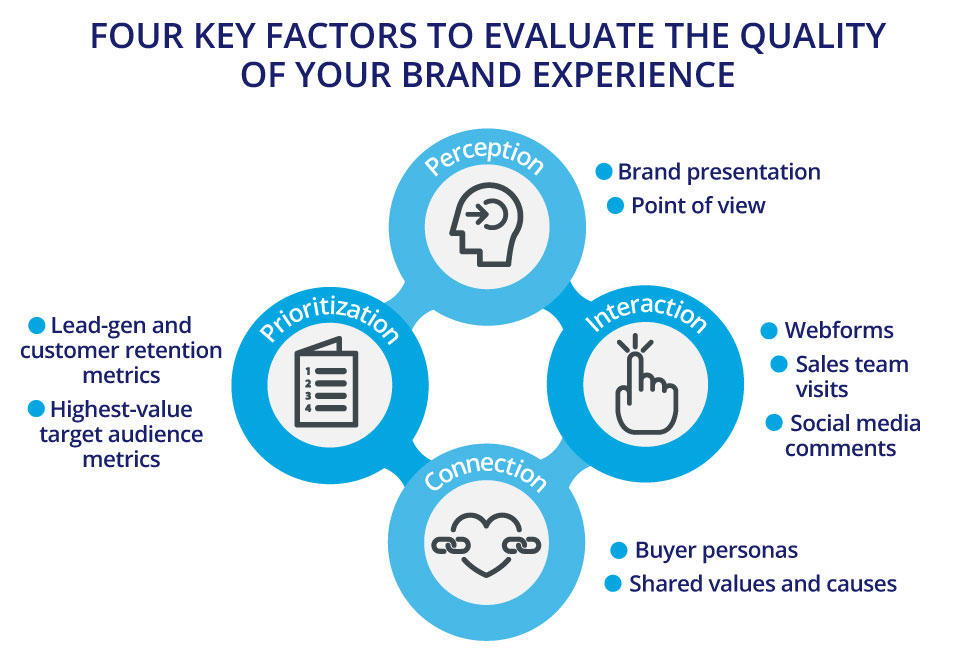The Brand Experience: Elevate Your Brand Impact and Loyalty

It’s not always immediately clear why some marketing strategies work and others don’t. Often, though, it comes down to brand experience. Initial interactions with your brand set the tone for your customer relationship.
Your brand values, marketing, product experience, customer service and every other customer touchpoint for your business work together to create a lasting impression of your brand. This is brand experience. Even when potential customers aren’t spending money, they’re still invested in your brand because your value system matches theirs.
Brand experience at work
Tapping into the mindset of your consumer base is a beneficial practice to cement the longevity of your brand; it’s also an essential tool for identifying your mission and how to implement that within your marketing strategy. Some businesses do that better than others.
Giving back
TOMS Shoes burst onto the footwear scene in 2009 with an eco-friendly canvas shoe millennials loved. The shoe’s simple design appealed to some, but the One for One campaign solidified the brand’s success. For each pair sold, another pair of the same shoes was given to a child who wouldn’t otherwise be able to afford shoes at all. The TOMS mission became their customers’ mission.
Community
Kickstarter has helped over 250,000 products get launched. By focusing on its mission (“We enable people to tell their stories”), the brand has connected millions of people around the globe with projects and products they believe in. Allowing creator stories to show up front and centre, Kickstarter inspires and empowers a vibrant community to use its purchasing power to support creators.
Providing value
HubSpot is a giant in the CRM, sales and marketing worlds for one reason: the brand’s content goes above and beyond. Webinars, blog posts, courses and certification are a few ways HubSpot provides value to its community. The content is original and helpful, locking it in as an authority on all things B2B.
Evolving brand experience
As with any aspect of marketing, brand experience is a work in progress. What works today won’t necessarily work tomorrow. Take TOMS, for example. After years of success, the brand became stagnant, requiring relief funds during the pandemic. Newer generations weren’t interested in the shoe or the mission. Gen Z has other ideas about what they want their dollars to support, and TOMS had to shift to profit donations for “grassroots good” that would meet their customer’s requirements for a positive brand experience.
Not every brand shifts elements of their experience in response to declining sales or customer dissatisfaction. It can also be part of a company’s renewed mission or values. For example, Kickstarter expanded on the idea of a global community working together. The brand increased its commitment from limiting its environmental impact to becoming a carbon-neutral company.
On the other hand, HubSpot is looking internally by moving its customer experience strategy from a funnel to a flywheel. The flywheel lets a brand look at its growth momentum from a different perspective. Doing so changed how the brand views growth, attracting leads, conversions and gaining brand loyalty.
Not just brand loyalty, but brand experience!
Lots of brands are happy with loyal customers. As they should be. However, losing a loyal customer is easy if elements are missing from the complete brand experience. To measure brand experience, your strategy should review these elements: perception, interaction, connection and prioritization.

- Perception: How your brand presents itself to the world and how it is perceived forms a large part of the brand experience. Make sure your brand persona goals and results are in alignment.
- Interaction: Create space for your audience to respond and interact. Not only does it further your brand awareness, but it also provides valuable feedback on which product features and content work and which don’t. Just because you think it’s a good idea, doesn’t mean your customers do.
- Connection: Know your target audience and speak directly to them. Know their names and what moves their hearts. Generic marketing and interactions are a sure way to lose the connection.
- Prioritization: Analyze your lead-gen and customer retention metrics, focus on those related to your highest-value target audience and prioritize the brand experience improvements that will grow that specific audience. You can’t be all things to all people, so don’t even try.
By connecting these elements, loyal customers turn into brand fans, sharing their enthusiasm with other like-minded consumers. How your customers feel about your product and the words they use to describe your brand represent their feelings about it.
Is your brand winging the experience?
Your product may not be as charitable as TOMS, as connected as Kickstarter or as content-forward as HubSpot, but that doesn’t mean you can’t gain something from their successful models. A brand experience should be positive and promote values that make customers feel something about your brand’s identity. These feelings should be associated with your brand’s market identity, giving it a leg up on competitors.
Not sure where to start? Mindspin offers brand experience audits and branding and identity design that will clear up the confusion and put your brand on the path to success.
Tanja Groos, Founder and Director, Mindspin® Studio Inc.
Tanja Groos is a Founder and Strategy Director with more than 25 years of experience in branding and digital marketing. She has a strong background in developing and implementing marketing strategies, gained from collaborating with leaders and managers in consultative and service-based industries. Her efforts have tripled sales, surpassed top industry competitors online, and enhanced brand credibility for her clients.
Tanja’s award-winning branding work and marketing insights have been featured in national showcases and publications like “The Hamilton Spectator” and “Identity Solutions.” She received the Entrepreneurial Recognition Award from the Government of Canada. Tanja is passionate about helping people connect with services that enhance their lives and guiding readers in achieving their business growth dreams by explaining how marketing gets them there.
Follow Tanja on LinkedIn













Leave a Reply
Want to join the discussion?Feel free to contribute!